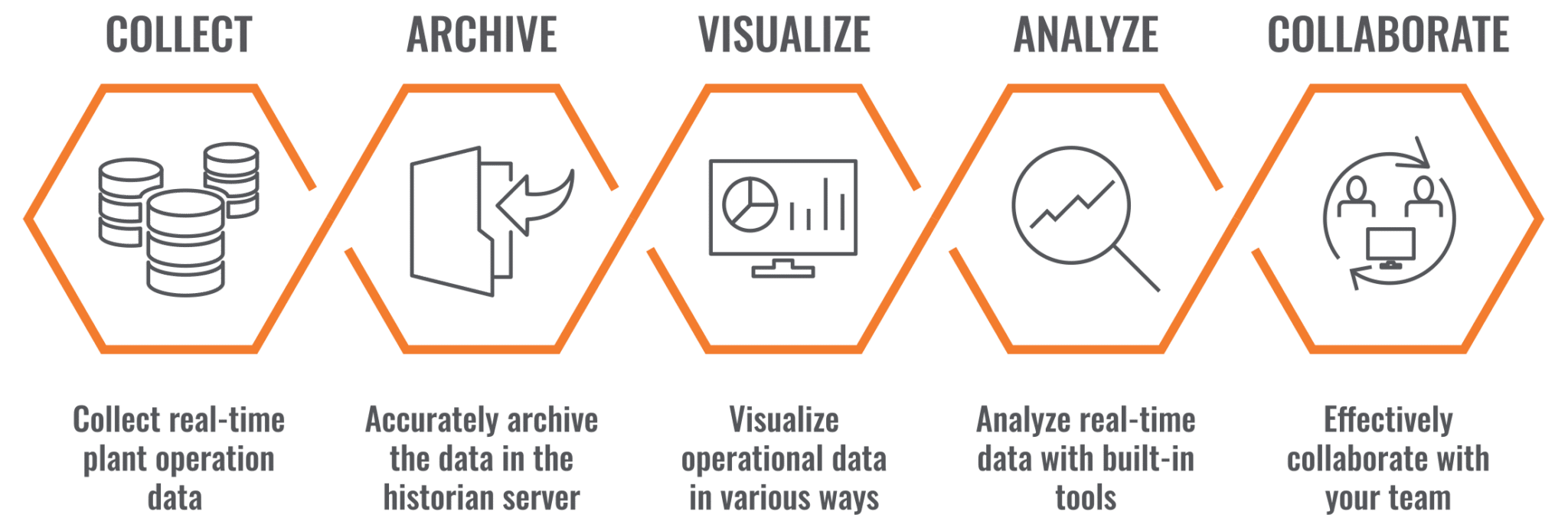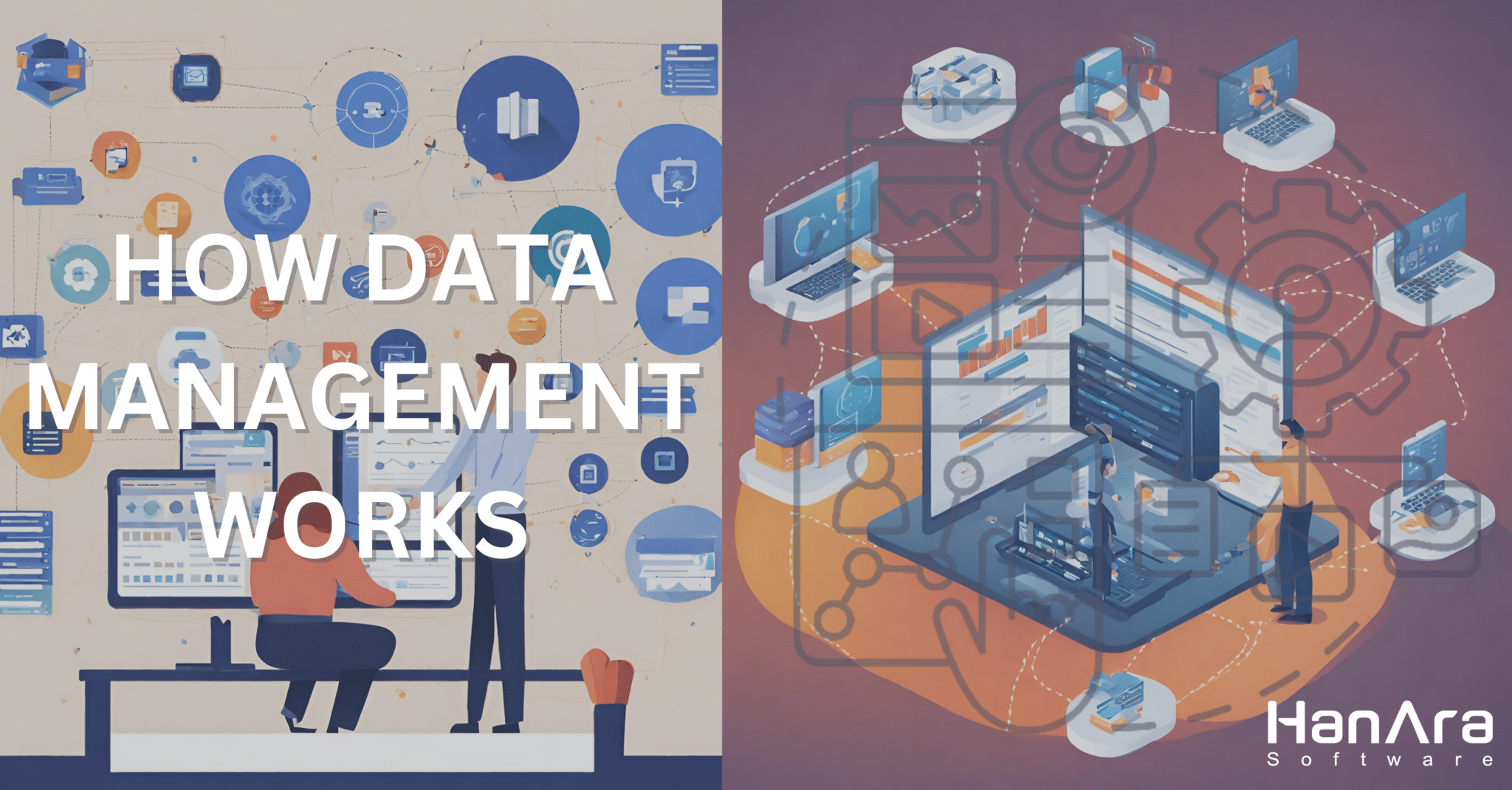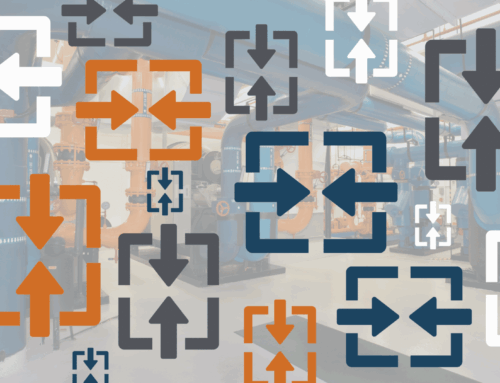Data is everywhere. From the moment we wake up to when we go to bed, we are constantly generating, consuming, and interacting with data. Every action we take, every decision we make, and every process we engage in is driven by data, whether we realize it or not. Data is particularly abundant in the industrial process and discrete industries. There are countless sensors, machines, and systems continuously generating vast amounts of information.
The process and discrete industry have made advancements to better handle information management, analysis, and sharing to keep up with this ocean of data. Unfortunately, the mere existence of data does not guarantee its usefulness. Without proper management, data can remain untapped, and its potential can be left unrealized. To transform this data into meaningful insights, the field of data management (DM) has appeared to organize information. Let’s dive into what it is and how it helps process and discrete industries improve efficiency and productivity in day-to-day business and operations.
What is Data Management?
Data management is a comprehensive approach to collecting, organizing, visualizing, and learning from your data. It encompasses a range of practices, architectures, and tools designed to ensure consistent access to and delivery of data across an organization. Whether you’re in Operations & Maintenance, Engineering, or Research & Development, you can tailor data management to meet your specific needs and drive progress.
Definition
According to Gartner, data management “consists of the practices, architectural techniques, and tools for achieving consistent access to and delivery of data across the spectrum of data subject areas and data structure types in the enterprise, to meet the data consumption requirements of all applications and business processes.” Data management implementation includes new processes, strategies, or software tools, resulting in improvement. Dataversity’s article echoes this focus on improvement in “What Is Data Management? Definition, Benefits, Uses,” noting data management is a tool to “maintain and improve the business.”
Data management is a broad study area that includes topics like data architecture, modeling, quality, governance, and security. It encompasses the theoretical and conceptual foundations of managing and utilizing data effectively within an organization. Data management continuously evolves, with new advancements and technologies, best practices, and standards emerging to address the ever-growing challenges of handling large volumes of complex data.
As a practice or process, data management refers to the practical application of knowledge, skills, and techniques to manage an organization’s data assets effectively. It involves steps and activities to transform raw data into meaningful insights, including data collection, processing, analysis, and visualization. Effective data management practices help organizations maintain data integrity, minimize data duplication, and ensure that data is readily available when needed. Organizations can consistently and efficiently manage their data by following a structured data management process, enabling them to make data-informed decisions and optimize their operations.
Finally, data management can be a tool or a set of tools used to facilitate data management. These tools include software applications, databases, data warehouses, and data analytics platforms. Data management tools provide organizations with the necessary infrastructure and capabilities to store, organize, and analyze large volumes of data effectively. By leveraging these tools, organizations can automate and streamline their data management processes, extract valuable insights, and make informed decisions more straightforward.
While data management encompasses a broad range of concepts, practices, and tools, a robust data management solution is one of the most critical components of an effective data management strategy.
What is a Data Management Solution?
At the heart of effective data management lies a powerful data tool, commonly referred to as a data historian. A historian is the foundation for gathering and centralizing all your critical data. It provides a secure and accurate basis for a smart plant. By collecting and archiving information from various sources, the solution enables you to visualize, analyze, and collaborate. Above all, this empowers you to understand your plant’s status at a glance and make data-informed decisions with confidence.

A data management tool has five key areas of focus:
Collect Real-Time Plant Operation Data
The solution collects real-time data from various sources throughout a plant, including equipment, PLCs, and control systems. It then integrates this data with context. The solution then captures a comprehensive view of the plant’s operations. This enables organizations to monitor and track key performance indicators (KPIs) in real-time. This real-time data collection allows for quick identification of potential issues, facilitating proactive decision-making and troubleshooting.
Accurately Archive Data in the Historian Server
Once the real-time data is collected, the solution securely stores and archives the information in a historian server. The historian server acts as a central repository for all historical data, providing a reliable and accessible source of information for future analysis and reporting. The system ensures that the data is accurately timestamped and organized. This makes it easy to retrieve and analyze historical trends and patterns.
Visualize Operational Data in Various Ways
A historian offers a range of visualization tools to help users understand the vast amounts of operational data. These visualizations can include interactive dashboards, charts, graphs, and process graphics. Therefore, they all provide a clear and intuitive representation of the plant’s operational performance. By visualizing data in various ways, organizations can quickly identify trends, anomalies, and opportunities. This enables them to make data-informed decisions and optimize their operations.
Analyze Real-Time Data with Built-In Tools
In addition to visualization capabilities, the solution often includes built-in analytics tools that allow users to perform real-time data analysis. These tools can consist of statistical analysis, enabling organizations to extract valuable insights from their operational data. By analyzing real-time data, organizations can identify inefficiencies, detect potential equipment failures, and optimize processes. This leads to improved performance and reduced downtime.
Effectively Collaborate with Your Team
A data management solution promotes collaboration among team members by providing a centralized platform for accessing and sharing operational data. The solution ensures that the right people have access to the right information at the right time. This is done with role-based access control and secure data-sharing capabilities. This collaborative environment fosters better communication, knowledge sharing, and decision-making across different departments and levels of the organization.
Leveraging these five critical functions of a data platform is incredibly beneficial. Through it, organizations in the industrial process and discrete industries can effectively collect, archive, visualize, analyze, and collaborate around their operational data. Most importantly, this holistic approach to data management enables organizations to optimize their processes, improve efficiency, and drive continuous improvement.
How a Data Management Solution Works
A data management solution pulls information from various sources together in one location for industrial operations. A data management solution is designed to efficiently handle the vast amounts of data generated within an industrial operation. It achieves this by combining hardware and software components that work together seamlessly. Here’s a closer look at the technical aspects of how a data management solution functions:
Data Acquisition
The journey of data begins with its acquisition from various sources, such as sensors, equipment, and control systems. The data management solution employs communication protocols like OPC (Open Platform Communications) to connect with these data sources and retrieve the relevant information.
Data Transmission
Once the data is acquired, it needs to be transmitted to the central processing unit of the data management solution. The transmission is often accomplished using a gateway device, which bridges the data sources and the primary server. The gateway interprets the data and sends it to the server for real-time and historical use.
Data Buffering
In some cases, network interruptions may result in communication issues. The gateway also serves as a temporary storage location to prevent data loss during such events. It continuously receives data from the source and stores it locally. Once the communication is re-established, the gateway delivers the stored data, ensuring no information is lost.
Data Synchronization
In enterprise-level data management solutions, server redundancy is often employed to enhance system reliability. Data redundancy involves setting up two identical servers – a primary and a secondary server. The data is synchronized between these servers in real time. If one server fails, the other can seamlessly take over, minimizing downtime and guaranteeing uninterrupted data access.
Data Security
Data management solutions prioritize the security of the collected and stored information. One approach is implementing physical one-way communication. This type of communication means that data can only be transmitted from the control network (where the data sources reside) to the internal network (where the servers and applications are located). Any communication attempts from the internal network to the control network are physically blocked, creating a secure barrier against potential cyber threats.
By leveraging these technical components and processes, a data management solution ensures the reliable collection, transmission, storage, and protection of industrial data. This robust foundation enables organizations to harness the power of their data for analysis, visualization, and decision-making.
How Data Management Software Improves Operations
Implementing a data management software platform offers numerous benefits that can transform your operations. By leveraging the power of data, organizations can gain deeper insights, streamline processes, and make informed decisions. Here are the top three reasons why investing in a data management solution is crucial:
Enhanced Data Analysis
A data management platform can help you gain a comprehensive understanding of your operations. Data management software enables you to visualize and contextualize data from various sources, providing a holistic view of your organization’s performance in real-time and historically. With powerful analytics tools, you can dive deep into the status of your equipment, identify trends, and create comparative charts and metrics. This level of data analysis empowers you to uncover hidden patterns, identify improvement opportunities, and optimize your processes for maximum efficiency.
Centralized Information Access
One of the primary challenges faced by organizations is the presence of information silos. When data is scattered across different systems and departments, it becomes difficult for teams to collaborate and make informed decisions. A data management platform addresses this issue by collecting, archiving, and sharing information in a centralized repository. Ensuring all organization members have access to the same reliable and up-to-date data can foster a culture of transparency and collaboration. This centralized approach eliminates confusion, promotes understanding, and enables seamless communication across different levels of the organization.
Data-Informed Decision Making
In today’s competitive landscape, making accurate and timely decisions is crucial for success. A data management platform empowers organizations to avoid guesswork and intuition-based decision-making. By providing access to real-time data and advanced analytics tools, a platform enables you to make informed decisions. You can quickly identify trends, anticipate challenges, and seize opportunities based on factual insights rather than assumptions. This approach improves the quality of your decisions and reduces the risk associated with implementing new ideas and processes. Therefore, with data management software, you can confidently navigate complex scenarios and drive continuous improvement.
Above all, data management software provides a unified platform for data analysis, information centralization, and data-informed decision-making. By leveraging these capabilities, organizations can unlock their data’s true potential, drive operational efficiency, and achieve sustainable growth.

What to Look for in a Data Management Solution
When considering a data management tool, there are several key factors to remember when selecting a solution that provides the most value and return on investment (ROI). That being said, here are nine essential features and considerations to look for in a data management solution:
- Scalability: Ensure the platform can handle your organization’s growing data needs and scale seamlessly as your business expands.
- Robust Security: Prioritize solutions offering advanced cybersecurity measures and data encryption to protect sensitive information from potential threats.
- Comprehensive Support: Look for vendors that provide reliable and responsive support to help you navigate any challenges and ensure smooth implementation and operation.
- Flexibility: Choose a platform that adapts to your organization’s unique requirements and offers features and functionality options that align with your goals and processes.
- User-Friendly Interface: Opt for a solution with an intuitive and user-friendly interface to ensure easy adoption and reduce the learning curve for your team.
- Integration Capabilities: Consider a platform that seamlessly integrates with your systems for a cohesive data ecosystem.
- Access Management: Look for granular access control features to ensure that the right people can access the right data, promoting collaboration while maintaining security.
- Performance and Reliability: Evaluate the platform’s performance metrics and uptime guarantees to ensure that it can handle your data processing needs efficiently and reliably.
- Alignment with Goals: The chosen data management tool should align with your organization’s primary objectives and help you achieve your desired outcomes.
How a Data Management Solution Helps
When assessing potential data management solutions, it’s crucial to involve stakeholders from various levels of the organization, including key decision-makers and end-users. Moreover, early engagement ensures that the selected platform addresses the team’s needs and pain points, fostering buy-in and successful adoption.
In conclusion, by carefully considering these factors and seeking a solution that offers the most value, you can empower your organization to maximize its data assets. Most importantly, the right data management tool will give your team the insights, efficiency, and competitive edge needed to thrive in today’s data-driven landscape.
Remember, investing in a robust data management platform is not just about technology; it’s about enabling your organization to focus on what matters most and allocating resources toward strategic initiatives that drive growth and success.
How We Help
At HanAra, we’re committed to helping our customers harness the full potential of their data. Our advanced data historian, HanPrism, securely stores and centralizes your information, enabling instant data analysis and empowering you to optimize your operations. Contact us today to learn how HanPrism can transform your operations through effective data management.






